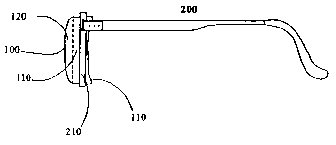Une partie des informations de ce site Web a été fournie par des sources externes. Le gouvernement du Canada n'assume aucune responsabilité concernant la précision, l'actualité ou la fiabilité des informations fournies par les sources externes. Les utilisateurs qui désirent employer cette information devraient consulter directement la source des informations. Le contenu fourni par les sources externes n'est pas assujetti aux exigences sur les langues officielles, la protection des renseignements personnels et l'accessibilité.
L'apparition de différences dans le texte et l'image des Revendications et de l'Abrégé dépend du moment auquel le document est publié. Les textes des Revendications et de l'Abrégé sont affichés :
| (12) Demande de brevet: | (11) CA 2416674 |
|---|---|
| (54) Titre français: | REVETEMENT DE VERRE OPTIQUE |
| (54) Titre anglais: | OPTICAL LENS COATING |
| Statut: | Réputée abandonnée et au-delà du délai pour le rétablissement - en attente de la réponse à l’avis de communication rejetée |
| (51) Classification internationale des brevets (CIB): |
|
|---|---|
| (72) Inventeurs : |
|
| (73) Titulaires : |
|
| (71) Demandeurs : |
|
| (74) Agent: | KIRBY EADES GALE BAKER |
| (74) Co-agent: | |
| (45) Délivré: | |
| (86) Date de dépôt PCT: | 2001-07-20 |
| (87) Mise à la disponibilité du public: | 2002-01-31 |
| Licence disponible: | S.O. |
| Cédé au domaine public: | S.O. |
| (25) Langue des documents déposés: | Anglais |
| Traité de coopération en matière de brevets (PCT): | Oui |
|---|---|
| (86) Numéro de la demande PCT: | PCT/US2001/023025 |
| (87) Numéro de publication internationale PCT: | WO 2002008820 |
| (85) Entrée nationale: | 2003-01-20 |
| (30) Données de priorité de la demande: | ||||||
|---|---|---|---|---|---|---|
|
La présente invention concerne un verre optique (100) sur le bord (110) duquel est fixé un revêtement coloré. Le dispositif peut améliorer l'aspect esthétique de lunettes du fait qu'il réduit l'apparence du cercle blanc qui existe autour du périmètre de la face du verre lorsqu'on regarde les lunettes de face et qu'il réduit l'aspect du film blanc sur le bord des verres lorsqu'on regarde les lunettes de profil. Ce dispositif peut également réduire les reflets du verre optique produits par la lumière qui entre par le bord du verre.
An optical lens (100) having a colored coating affixed to the edge (110) of
the lens. The apparatus may enhance the cosmetic appearance of eyeglasses by
reducing the appearance of the white ring appearing along the perimeter of the
face of lens when viewing eyeglasses from the front, and by reducing the
appearance of the white film on the edge of lenses when viewing eyeglasses
from the side. The apparatus may also reduce the glare of the optical lens
from light entering through the edge of the lens.
Note : Les revendications sont présentées dans la langue officielle dans laquelle elles ont été soumises.
Note : Les descriptions sont présentées dans la langue officielle dans laquelle elles ont été soumises.

2024-08-01 : Dans le cadre de la transition vers les Brevets de nouvelle génération (BNG), la base de données sur les brevets canadiens (BDBC) contient désormais un Historique d'événement plus détaillé, qui reproduit le Journal des événements de notre nouvelle solution interne.
Veuillez noter que les événements débutant par « Inactive : » se réfèrent à des événements qui ne sont plus utilisés dans notre nouvelle solution interne.
Pour une meilleure compréhension de l'état de la demande ou brevet qui figure sur cette page, la rubrique Mise en garde , et les descriptions de Brevet , Historique d'événement , Taxes périodiques et Historique des paiements devraient être consultées.
| Description | Date |
|---|---|
| Inactive : CIB enlevée | 2018-07-13 |
| Inactive : CIB attribuée | 2018-07-13 |
| Inactive : CIB expirée | 2015-01-01 |
| Inactive : CIB enlevée | 2014-12-31 |
| Inactive : CIB de MCD | 2006-03-12 |
| Inactive : CIB de MCD | 2006-03-12 |
| Le délai pour l'annulation est expiré | 2005-07-20 |
| Demande non rétablie avant l'échéance | 2005-07-20 |
| Réputée abandonnée - omission de répondre à un avis sur les taxes pour le maintien en état | 2004-07-20 |
| Inactive : CIB attribuée | 2003-03-25 |
| Inactive : Page couverture publiée | 2003-03-18 |
| Inactive : Notice - Entrée phase nat. - Pas de RE | 2003-03-14 |
| Inactive : Inventeur supprimé | 2003-03-14 |
| Demande reçue - PCT | 2003-02-20 |
| Exigences pour l'entrée dans la phase nationale - jugée conforme | 2003-01-20 |
| Demande publiée (accessible au public) | 2002-01-31 |
| Date d'abandonnement | Raison | Date de rétablissement |
|---|---|---|
| 2004-07-20 |
Le dernier paiement a été reçu le 2003-07-08
Avis : Si le paiement en totalité n'a pas été reçu au plus tard à la date indiquée, une taxe supplémentaire peut être imposée, soit une des taxes suivantes :
Veuillez vous référer à la page web des taxes sur les brevets de l'OPIC pour voir tous les montants actuels des taxes.
| Type de taxes | Anniversaire | Échéance | Date payée |
|---|---|---|---|
| Taxe nationale de base - générale | 2003-01-20 | ||
| TM (demande, 2e anniv.) - générale | 02 | 2003-07-21 | 2003-07-08 |
Les titulaires actuels et antérieures au dossier sont affichés en ordre alphabétique.
| Titulaires actuels au dossier |
|---|
| ABBY AYOUB |
| Titulaires antérieures au dossier |
|---|
| S.O. |